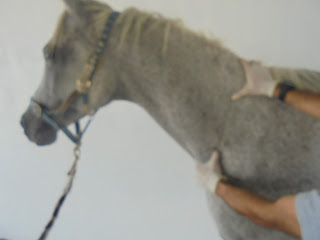SHS VETERINARY CENTER The Pride of Al Wathba
SHS Veterinary Center: It offers a comprehensive and specialized care for horses, the clinical service for equines covers all pathologies related to the horse, in the same place 24 hours a day, 365 days a year.
We offer the mobile clinic service, equipped with mobile units equipped to provide services that do not require hospitalization. Everything with attention 24h.
Additional offers the training service for students of Veterinary Medicine and practicing veterinarians oriented in equine medicine, as well as training courses.
يتم توفير رعاية خاصة وشاملة للخيول، كما تغطي الخدمة السريرية جميع الأمراض المتعلقة بالخيل في نفس المكان لمدة 24 ساعة في اليوم، 365 يوماً في السنة.
نحن نقدم خدمة العيادة المتنقلة المجهزة بوحدات متكاملة التي لا تتطلب حاجة الدخول للمستشفى مع الرعاية والاهتمام على مدار 24 ساعة.
بالإضافة إلى خدمة تدريب طلاب الطب البيطري والممارسين الأطباء المتخصصين في طب الخيل كما نقدم دورات تدريبية.
Exam Tools
To perform a basic
physical examination, it will help to have a few supplies—a thermometer, a
stethoscope, and a watch that allows you to count seconds. Most lay people like
digital thermometers because the time for a reading is much less—about one minute—for a digital compared
to three to five minutes for a traditional glass thermometer. In the case of
foals, it is probably kinder and possibly safer to use the soft digital ones
rather than the rigid glass types, especially if the foal is particularly
rambunctious. The stethoscope, of course, is an instrument that magnifies
sound. This will allow you to hear the heart beating clearly and better distinguish
the sounds of breathing.
The Power of
Observation
The good physical examination first
involves observing. A great deal can be learned just by observing posture,
attitude, and the environment. It is a skill that usually must be taught, or at
least honed, as not all of us are naturally observant.
Most of the time learning
to be more observant just entails learning what to watch for—patterns of lying down
to rest, normal responses to exercise, normal appetite, etc. Observation from
outside the stall or paddock can give valuable information.
The Basic Examination
After observing your
horse, you determine that he is not well or is injured. If the injury/illness
is mild (small wound, mild colic), you
can perform your basic physical examination first before calling your
veterinarian. Obviously if the horse is in severe pain (thrashing, rolling, or
severely bleeding), you call your veterinarian first, then perform your
physical examination. Or, you can perform your examination while waiting for
your veterinarian to call you back if he/she must be paged.
Rectal Temperature
The rectal temperature
can be taken easily on most horses. Approach the horse from the side—do not stand directly
behind the horse in case he decides to kick—shake the thermometer down if using a
mercury type. Place a small amount of lubrication (petroleum jelly or KY Jelly)
on the thermometer; then insert it gently into the rectum. Make sure the
thermometer is tied to a clip and attached to the tail to avoid losing it in
the stall (or the horse). If using a glass thermometer, you can move on to the
heart and respiratory rate at this time.
The normal rectal
temperature of a horse is 99.5-101.5° (A neonatal foal’s normal temperature is
between 100.0-102°F).
Pulse and Respiration
The heart rate (pulse) and respiratory
rate can be taken without a stethoscope, if one is unavailable. The stethoscope
just makes it much easier. The pulse can be taken from the lingual artery,
which is on the bottom side of the jaw, where it crosses over the bone. The
pulse can be taken for 15 seconds, then multiplied by four to achieve the heart
rate in beats/minute. If a stethoscope is available, then listening to the
heart is easiest on the left side of the horse, just behind the elbow. Each
“lub-dub” of the heart is considered one beat. The normal heart rate for a
horse is 24-36 beats per minute (bpm). The heart rate for foals varies
depending on age. Newborn foals have a heart rate of around 80 beats per minute
(bpm). Foals within the first few weeks of life vary between 70-100 bpm. The
respiratory rate can be taken by watching the horse breathe or feeling the air
come out of his nostrils. The stethoscope can be used to listen to the breaths
as they travel across the trachea or in the chest. The trachea should sound
clear. The normal respiratory rate for adult horses is eight to 12
breaths/minute. Newborn foals have respiratory rates that are quite high,
ranging from 60-80 breaths per minute. Foals within the first weeks of life
have resting respiratory rates from 20-40 breaths per minute.
Mucous Membranes
Another indicator of wellness is the color
of the mucous membranes or gums. Healthy horses have nice pink gums that are
moist to the touch. Capillary refill time also can be performed while looking
at your horse’s gums. Press your finger on the gum, then release—the time it takes for
the area to turn from white (where you pressed out the blood) back to pink is
the capillary refill time. It should be around two seconds. Gums that are dark
red, bright or brick red, blue, or even white with a prolonged capillary refill
time, usually indicate one of the various forms of shock. Your veterinarian
should be summoned immediately.
Evaluation of the heart includes not just
the rate, but also the rhythm and the presence or absence of a murmur. If a
horse is displaying signs of colic, the abdomen will be ausculted for sounds of
a healthy, moving gastrointestinal tract, or the more ominous silence of a GI
tract in stasis.
SHS VETERINARY CENTER
The Pride of Al Wathba















Comentarios
Publicar un comentario